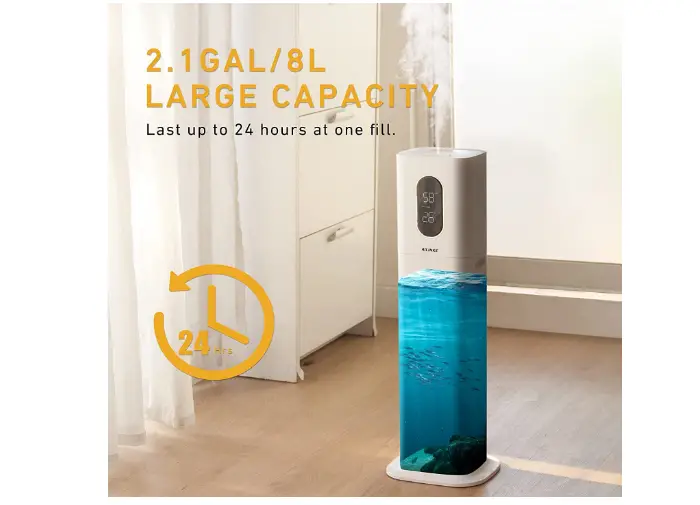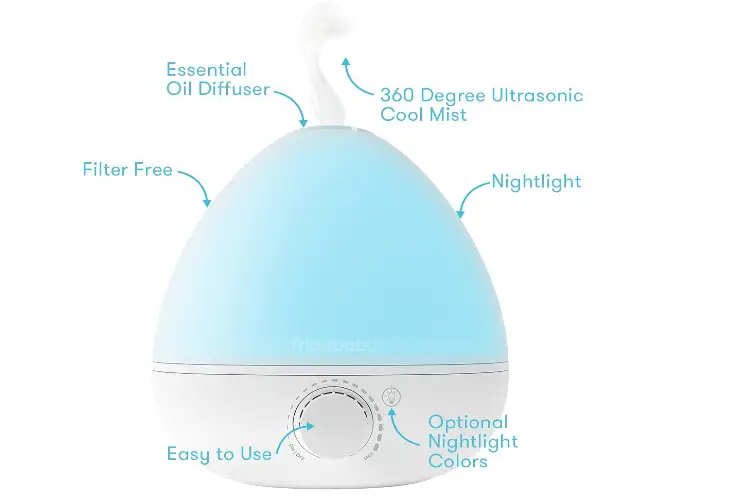Learn the best ways to use a Humidifier for your Baby nursery.
While it’s not a must-have gadget, a humidifier is a great addition to a baby’s nursery. On the flip, if not used properly it can be a health hazard. Humidifiers add humidity to the air to create the best possible atmosphere. It prevents dry air that can lead to rough, dry skin and worsen certain skin conditions such as rashes or eczema.
When used and placed correctly, a humidifier can be of great help to your baby. For instance, when it’s cold, and the air is dry, it helps to keep the air moist, preventing the baby from developing dry skin and dry lips.
A humidifier is also helpful when the baby has a stuffy nose. The moisture helps to unblock the nose, helping the baby sleep better and minimizing snoring.
Now that you know it’s okay and beneficial to use a humidifier in a nursery, there are certain things to know before acquiring or using one.
Hey! By the way… any links on this page that lead to products on Amazon are affiliate links and I earn a commission if you make a purchase.
Thanks in advance – I really appreciate it!
Click on image for more information
Here are essential things to take note of when choosing a humidifier for a baby.
Table of Contents
- How To Use A Humidifier For Baby
- 1 Pick a suitable spot to place the humidifier
- 2 Connect to the power supply properly
- 3 Monitors the room’s humidity levels
- 4 Make sure the humidifier is big enough for the room
- 5 Use distilled water instead of tap water
- 6 It’s not recommended to add essential oils, salt, or other stuff in humidifiers for babies
- 7 Monitor the water levels to avoid water running out
- 8 Maintain a regular cleaning and maintenance schedule
- 9 Keep the windows and doors closed
- 10 Be cautious as a humidifier can be hazardous
- 11 Upgrade for advanced features
- 12. Make sure you are using a cool-mist humidifier
How To Use A Humidifier For Baby
No products found.Click on image for more information
1 Pick a suitable spot to place the humidifier
Knowing the right place to place a humidifier in a baby’s room is very important. Here are a few things to know about the placement.
- Place the humidifier away from the baby’s cot, preferably at a place where the baby cannot reach. Note; usually, the area where the humidifier is placed has more moisture than the rest of the areas.
- While it’s okay placing it on the floor, it’s recommended to place it above 2 feet from the floor.
- Don’t place or put it near wooden surfaces that can be damaged by moisture.
- Avoid placing it where there is direct sunlight especially near a window.
Dont’s
There are certain spots that humidifiers shouldn’t be placed on or near at all. They include;
- Near a vent.
- Near an electrical outlet.
- Near heated spots.
- Near bundles of electrical wires or cables.
2 Connect to the power supply properly
While there are cordless humidifiers most of them are not the best for babies. That’s why most nursery humidifiers are corded. And that is where the issue comes in. The power cable poses danger to the baby, especially for older babies. The baby can easily trip over and this can also make the humidifier fall causing breakage.
If it’s possible connect the humidifier directly to the power socket and hide the connecting cable. Also, make sure the baby can’t access this area if they are mobile.
3 Monitors the room’s humidity levels
The ideal time to use a humidifier is when the air indoors is dry. The easiest way to know if the air is dry is by using a hygrometer that works just like a thermometer.
The best humidity level for a sleeping environment is between 30% to 50% humidity level according to Mayo Clinics. If the hygrometer reading is below this level use a humidifier, however, if it’s higher than 50% use a dehumidifier to bring the humidity level down.
Remember, when the humidity levels are high the ambient temperature is hotter while low humidity (winter) translates to lower temperatures.
4 Make sure the humidifier is big enough for the room
Humidifiers are available in different sizes for different room sizes. If you use a small humidifier in a spacious nursery or bedroom the moisture produced won’t be enough for the entire room. On the other hand, if you place a model meant for spacious nurseries in a smaller nursery you will end up with water condensation on surfaces that can be a breeding ground for bacteria or other microorganisms.
Click on image for more information

5 Use distilled water instead of tap water
Humidifiers need water to function. When using them for babies, it’s recommended to use distilled water that’s purified to keep the risk of contamination minimal. Water that isn’t distilled may have some minerals present and when emitted into the air, they can cause harm to your baby when they breathe the air. This also leads to the accumulation of minerals inside the humidifier and you will also start noticing white dust on different surfaces in the room.
6 It’s not recommended to add essential oils, salt, or other stuff in humidifiers for babies
Some humidifiers come with the option to add external chemical substances such as menthols and essential oils to provide aroma. If you decide to use any such substance, make sure to consult with your doctor first and take note of potential allergic reactions, especially if your baby has a respiratory condition like asthma.
If your baby has asthma symptoms or allergic reactions to certain things, ensure you talk to your doctor before using a humidifier. This is because humidifiers can worsen asthma or allergic symptoms if not used well.
7 Monitor the water levels to avoid water running out
A humidifier works by releasing the vapor into the air. After some time the water level in the unit goes down until it’s over. Luckily, most humidifiers automatically shut off once the water runs dry. A humidifier without this feature will start circulating dry air once the water finishes and you aren’t there to notice, which can cause problems for your baby.
Most humidifiers can run for between 12 hours and 24 hours when filled up. The water tank determines the run-time, meaning the bigger the water tank, the bigger the run-time.
8 Maintain a regular cleaning and maintenance schedule
Humidifiers require regular care and cleaning like any other electrical equipment. If they aren’t cleaned, foreign microorganisms, including mold, bacteria, and mildew, can grow inside and cause damage to both the machine and its environment.
The cleaning instructions of the manufacturer should be adhered to firmly. Some good cleaning habits include;
- Use distilled water rather than tap to prevent mineral buildup inside the humidifier.
- Use a dedicated cleaning brush to clean the internals
- Empty the humidifier’s water tank and replace the water every day.
- When not in use, empty it, dry it and store it in a way that lets air circulate very well around it.
- Avoid high levels of humidity, levels greater than 50%. High humidity levels can support microorganism growth.
- Ensure your humidifier has an antibacterial filter to keep the internal water sterile. You should change this antibacterial filter regularly according to the manufacturer’s instructions.
- If you notice the humidifier is becoming louder check the fan motor.

9 Keep the windows and doors closed
If you want to maintain humidity levels within the required range it’s recommended to keep the door and windows closed when the humidifier is running. When the door or windows are open, there is a lot of air circulation leading to humid air leaving the room and cold dry air entering the room, especially if it’s old outside.
The only downside with keeping the windows and door closed is that the humidity level may get very high. The solution here is to invest in a unit that has an inbuild humidity monitor.
10 Be cautious as a humidifier can be hazardous
Using humidifiers has many benefits as we’ve said, but there are hazard risks when using them. These potential hazards include;
- Very high humidity – Because of a humidifier’s action, enclosed spaces can gain too high humidity not suited for them. According to the Mayo Clinic, the ideal humidity level for a home is between 30% and 50%, and getting above this level can cause problems.
- Allergies – Even though humidifiers are often used to prevent allergies in babies, they can also be an allergy trigger. For example, if a humidifier is filled up with undistilled water having contaminants, the contaminants will be pushed into the surrounding air by the humidifier and may affect your baby.
- Bacteria and Mold – If humidifiers aren’t cleaned well, they can harbor harmful bacteria and mold that’ll spill into the surrounding air and can make your baby sick.
- Water spill – Humidifiers may have leakages and spill water onto the floor, resulting in children slipping and getting injured.
- Electrocution – A humidifier is an electrical appliance and carries the risk of electrocution if its electrical connections are not done correctly.
11 Upgrade for advanced features
Like all other products, different types of humidifiers vary in terms of features and price. The price range of humidifiers is from as low as $15 to as high as $800 for advanced models. The budget models are mostly for humidifying small spaces, while as the price increases, you get single humidifiers that can humidify very large spaces with ease. If you find the model you have isn’t the best for you, consider upgrading. But this time, look for convenience features such as:
- filterless options
- rotating nozzles
- built-in intelligent sensors
- UV light
- Night lights
- LED display
- quiet-operation modes
- Sounds
12. Make sure you are using a cool-mist humidifier
Now, there are different types of humidifiers, which include steam vaporizers, evaporators, ultrasonic humidifiers, impellers, and central humidifiers.
However, not all of them are good for babies. According to the American Academy of Pediatrics (AAP), the best type of humidifier for babies is a cool mist humidifier which is either an Impeller or ultrasonic type.
As the name suggests, cool mist humidifiers produce a cool must making a conducive atmosphere for babies. In contrast, warm mist humidifiers produce warm moisture that isn’t comfortable for babies and can even cause burns so isn’t recommended.
The reason why evaporators are not ideal for babies is that they use an internal fan spinning at high speeds to evaporate water as mist into the air. Because of the spinning, there’s a risk of expelling too much mist into the air that could create a breeding ground for harmful microorganisms, and therefore not good for babies.
On the other hand, vaporizers create humidity by heating water and cooling it before releasing it into the air. Because of the heat, there’s a high risk of burn if it touches the skin and therefore shouldn’t be used near a baby.
So:
If you have a different type rather than a cool-mist type we recommend not using it for the safety of your baby.

